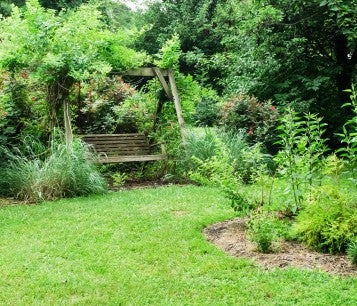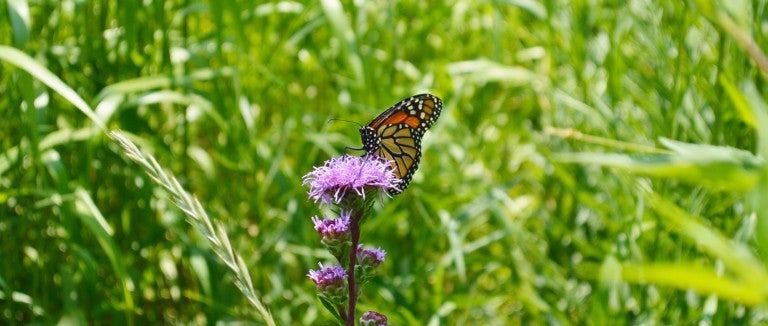Standing in the street and admiring each other’s gardens one day, Sherrie Pelsma and her neighbor made a discovery: They’d become hosts to a buzzing block party.
“We could actually see the air traffic of bees and butterflies crossing the street between our two habitats,” recalls Pelsma. “I said, ‘Wow, how cool would it be if everybody had a little strip?’ ”
Twenty-two of those little strips—often called “hellstrips” due to their exposed location between hot asphalt and concrete—now bloom by the sidewalks of Pelsma’s community in Portland, Oregon. Once patches of lifeless turfgrass, the 6,000 square feet of mini-habitats are life preservers for native bees, many of whom can fly only a few blocks before running out of fuel.
“It’s not going to help wolves or bears,” says Pelsma, founder of Pollinator Parkways. “But we’re talking about really tiny creatures, so tiny spaces have a really big impact for them.”
Birds, squirrels and other wildlife also find sustenance in these urban oases. Every outdoor space, whether a transformed city plot or a suburban pocket prairie, matters to animals. Here’s how to reclaim land for wildlife well beyond your own backyard.
Rally the community
As a professional community organizer for a local nonprofit, Pelsma knows lasting change starts from the ground up. When she called a meeting on Nextdoor.com, a dozen neighbors responded. “They came up with the idea of parking strips specifically because they’re smaller than your yard, so it’s a little less intimidating,” she says. “And people really wanted to beautify the neighborhood.”
Broadening her base, Pelsma reached out to a local nonprofit that recruits volunteers for restoration projects. Students and Boy Scouts braved November rains to remove sod and prepare beds. Homeowners played an important role, planning the gardens with Pelsma, overseeing volunteers and planting alongside them. The process ensures participants are invested and can serve as ambassadors for the program. “The point is also for them to be more informed,” says Pelsma, “so that they become stewards.”
Seek creative funding
$500 from the city covered initial plantings, but demand soon exceeded supply. When Pelsma learned that many grant-makers award only nonprofits, not individuals, she found a workaround: City Repair, a group dedicated to artistic and ecological endeavors, became a sponsor. Pelsma used its nonprofit status to apply for a $3,000 grant. “And then I was able to buy plants in bulk,” she says. “It was just this total game-changer.”
Public and private funding helps legitimize wildlife gardening, says Pam Sonneville, who has slowly replaced turfgrass in her Gaithersburg, Maryland, neighborhood with native plants. When she encounters skeptics, Sonneville points to external investment as proof of the plants’ value. She invites visiting experts—from landscape designers to wildlife advocates—and shares their positive feedback.
A humane backyard is a natural habitat offering wildlife plenty of food, water and cover, plus a safe place to live free from pesticides, chemicals, free-roaming pets, inhumane practices and other threats. And it's so easy to build!

Address human needs
As the grounds chair of her homeowners association (HOA), Sonneville emphasizes practical benefits. In one wet area where landscapers unsuccessfully planted grass seed, white wood asters now hold the ground and feed small native bees. “Before it was nothing but mud in the spring, and the water was coming down in front of people’s houses,” Sonneville says. “Now it’s probably 90% better.”
Wildlife-friendly plants also save time in Wilmette, Illinois, where retired attorney Charlotte Adelman planted a prairie in a hard-to-mow detention basin. “The mowers get stuck in the muck—it’s a wetland,” she says. “So [the park district supervisor] looked at it as a very practical alternative.”
Show and tell
Now a haven for Wilmette’s wild residents, Adelman’s prairie has inspired a garden club to promote pocket prairies throughout the community. Adelman looks for such opportunities wherever she sees bare ground and open minds; after she suggested a wildflower garden at the firehouse, the chief himself enthusiastically drilled holes for the plants.
Many of Sonneville’s projects—a wildflower strip outside the pool, a mini-meadow behind some townhouses—demonstrate how natural plantings evolve. As flowers beget more flowers, leaves replace expensive mulch and grass disappears, she reports financial savings and progress to the HOA board and in community newsletters.
But she and other advocates know there’s more at stake than the bottom line: Pelsma, an avid photographer, has witnessed bee declines up close. “There just aren’t as many, and there’s not as much variety,” she says. “I feel the loss really profoundly in my heart.”
Because she turned that loss into positive action, though, the buzz is growing louder in her community as each new parking strip fills a gap in the pollinator corridor. It all started with two neighbors, their gardens and a few butterflies and bees who showed them the way.
Want more content like this?
This was written and produced by the team behind All Animals, our award-winning magazine. Each issue is packed with inspiring stories about how we are changing the world for animals together.
Learn MoreSubscribe
